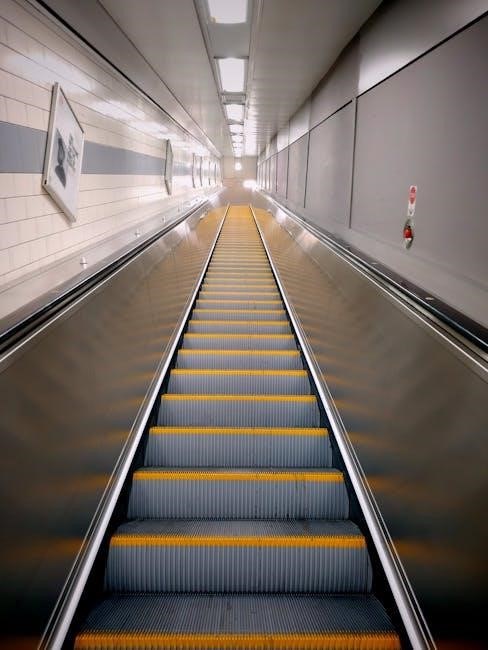Elevator guide rails are metal tracks that direct the elevator car, ensuring smooth movement and proper alignment. They are crucial for safety and efficiency, preventing accidents and reducing mechanical wear.
What Are Elevator Guide Rails?
Elevator guide rails are metal tracks installed in elevator shafts that guide the elevator car, ensuring smooth movement and proper alignment. They prevent the car from moving sideways, reducing mechanical wear and tear. These rails are crucial for safety and efficiency in elevator systems, ensuring reliable operation and preventing accidents. Their precise installation and durability make them a fundamental component in modern elevator systems.

The Importance of Guide Rails in Elevator Systems
Elevator guide rails are essential for ensuring the safe and efficient operation of elevator systems. They provide structural support, preventing the elevator car from deviating from its path and reducing mechanical wear. Guide rails are critical for maintaining alignment, which minimizes the risk of accidents and extends the system’s lifespan. Their stability ensures smooth movement, making elevators more comfortable and reliable for users. Without guide rails, elevators would lack the precision and safety required for modern buildings, making them indispensable in both residential and commercial settings;

Purpose and Function of Elevator Guide Rails
Elevator guide rails ensure the elevator car moves smoothly and stays aligned, providing stability and preventing lateral movement. They guide the car between floors, absorbing lateral forces and ensuring safe, efficient operation.
Providing Stability and Alignment
Elevator guide rails are essential for maintaining the stability and alignment of the elevator car as it moves between floors. They act as the backbone of the elevator system, ensuring the car remains straight and prevents any lateral wobble or misalignment. By securely guiding the car along its path, guide rails minimize the risk of uneven movement, which could lead to safety hazards or mechanical failures. Their precise engineering ensures smooth and consistent operation, making them a critical component for reliable elevator performance.
Ensuring Smooth Movement of the Elevator Car
Elevator guide rails play a crucial role in ensuring the elevator car moves smoothly and efficiently. By providing a fixed path, they minimize vibrations and jerky movements, allowing the car to glide effortlessly between floors. The rails are precisely engineered to reduce friction, ensuring seamless operation. Proper lubrication and alignment of the guide rails further enhance smooth movement, contributing to a comfortable passenger experience and reducing mechanical strain on the elevator system.

Types of Elevator Guide Rails
Elevator guide rails are categorized into fixed, movable, and telescopic types, each designed for specific functionalities and applications in elevator systems.
Fixed Guide Rails
Fixed guide rails are permanent components installed in elevator shafts, providing structural support and alignment for the elevator car. They are securely attached to the shaft walls or beams, ensuring stability and preventing lateral movement. Made from durable materials like steel, these rails are essential for maintaining the elevator’s position during operation. Their rigid design allows for smooth vertical movement while withstanding the forces applied by the elevator’s motion. Proper installation and alignment of fixed guide rails are critical for safe and efficient elevator performance.
Movable Guide Rails
Movable guide rails are adjustable components designed to accommodate specific elevator systems, such as hydraulic or freight elevators. These rails can shift horizontally or vertically to align with the elevator car, ensuring proper positioning during loading and unloading. They often feature rollers or hinges for smooth adjustment and are typically used in applications where the elevator car needs to move laterally. Movable guide rails enhance flexibility and safety, reducing wear on the system while maintaining alignment. They are particularly useful in industrial or high-capacity elevators.
Telescopic Guide Rails
Telescopic guide rails are specialized components used in elevator systems, particularly in machine rooms and elevator pits. These rails are designed to extend and retract, providing stability during the elevator’s vertical movement. They are essential for maintaining alignment and preventing wobbling, especially in high-speed elevators. Telescopic rails are often used in conjunction with buffers or safety devices to ensure smooth operation. Their adjustable nature allows them to accommodate varying car speeds and loads, making them a critical component for safety and efficiency in modern elevator systems.

Materials Used for Elevator Guide Rails
Elevator guide rails are typically made from durable materials like carbon steel or stainless steel, ensuring strength and resistance to wear and corrosion over time.
Steel Guide Rails
Steel guide rails are the most commonly used material in elevator systems due to their exceptional strength, durability, and resistance to wear and tear. High-quality carbon steel or stainless steel is typically utilized to ensure longevity and reliability. These rails are often heat-treated to enhance their hardness and load-bearing capacity, making them ideal for supporting heavy elevator cars and withstanding consistent movement. Steel guide rails are also cost-effective and widely available, making them a preferred choice for both residential and commercial elevators. Regular maintenance is essential to prevent corrosion and ensure optimal performance over time.
T-Rails and Other Specialized Materials
T-rails are a type of guide rail featuring a distinctive “T” shape, designed for enhanced structural integrity and alignment precision. They are frequently used in high-traffic elevator systems due to their robust design. Other specialized materials include aluminum rails for lightweight applications and fiber-reinforced polymers for exceptional durability and resistance to corrosion. These alternatives are chosen based on specific elevator requirements, ensuring optimal performance and compliance with safety standards like ASME and EN. Advanced materials are increasingly adopted for improved efficiency and longevity.
Safety Standards and Regulations
Global safety standards like ASME A17.1 and EN 81 regulate elevator guide rails, ensuring they meet strict safety, load capacity, and alignment requirements to prevent accidents.
International Safety Standards for Guide Rails
International safety standards, such as ISO 8383 and EN 81, provide strict guidelines for elevator guide rails, ensuring durability, alignment, and load-bearing capacity. These standards emphasize proper material selection, dimensional accuracy, and resistance to wear; Regular compliance testing is mandated to guarantee safety and reliability. Adherence to these norms minimizes risks of malfunctions and ensures seamless elevator operation, fostering trust in elevator systems worldwide.
ASME and EN Standards for Elevator Components
ASME A17.1 in the U.S. and EN 81 in Europe set rigorous standards for elevator components, including guide rails. These standards specify design, testing, and maintenance requirements to ensure safety and reliability. They cover load capacity, material strength, and corrosion resistance, guaranteeing compliance with global safety norms. Adherence to these standards is critical for the smooth operation of elevators in residential, commercial, and industrial settings, ensuring passenger safety and system longevity.
Installation and Maintenance
Installation and maintenance of elevator guide rails require precision to ensure alignment and functionality. Regular lubrication and inspections are vital to prevent wear and ensure safety.
Proper Installation Techniques

Proper installation techniques for elevator guide rails involve precise alignment and leveling to ensure smooth operation. Skilled technicians use specialized tools like laser levels and shims to secure the rails. Anchoring systems, such as bolts and brackets, are critical for stability. Protective coatings are applied to prevent corrosion. Adherence to manufacturer guidelines and safety protocols ensures reliability. Regular testing post-installation confirms proper functionality. These steps guarantee optimal performance and longevity of the elevator system.

Maintenance Requirements for Guide Rails
Regular maintenance of elevator guide rails is essential to ensure system efficiency and safety. This includes inspecting for wear, cleaning debris, and lubricating moving parts. Technicians check alignment and tighten loose fasteners to prevent misalignment. Damaged or worn sections must be replaced promptly to avoid elevator malfunctions. Lubrication schedules and material inspections are tailored to usage levels. Proper maintenance extends the lifespan of guide rails, reduces operational noise, and prevents costly repairs. Adhering to a routine maintenance plan ensures consistent elevator performance and passenger safety.

Common Challenges and Solutions
Challenges like wear and tear, misalignment, and corrosion can affect guide rail performance. Solutions include regular inspections, lubrication, and using durable materials to ensure longevity and functionality.
Wear and Tear of Guide Rails
Wear and tear on elevator guide rails can occur due to frequent use, friction, and heavy loads. Over time, this can lead to misalignment and uneven movement of the elevator car. Regular lubrication of the rails and proper alignment adjustments can help minimize wear. Inspections should be conducted periodically to identify signs of damage or excessive wear. Replacing worn-out guide rail segments promptly is essential to maintain smooth operation and prevent potential safety hazards. Durable materials, such as coated or hardened steel, can also extend the lifespan of guide rails in high-traffic environments.

Applications in Different Types of Buildings
Elevator guide rails are essential in residential, commercial, and industrial buildings, ensuring smooth elevator operation. They adapt to varying loads and usage patterns in different settings.
Residential Elevators
In residential elevators, guide rails ensure quiet and smooth operation, crucial for home environments. They are designed to withstand regular use while minimizing noise and vibration. Durable materials like steel are often used to maintain stability and alignment, even in smaller spaces. Customizable options cater to varying home sizes and architectural styles, providing reliable performance for daily use.
Commercial and Industrial Elevators
In commercial and industrial settings, elevator guide rails play a critical role in handling heavy loads and high traffic. They are typically made from durable materials like steel or specialized alloys to ensure strength and longevity. These rails are designed to withstand constant use, providing smooth and stable operation. They also support large elevator cars and ensure precise alignment, which is essential for safety and efficiency in busy environments. Regular maintenance is crucial to prevent wear and tear in industrial applications.
Manufacturing Process of Guide Rails
The manufacturing process involves cutting, machining, and heat treatment of raw materials to achieve precise dimensions and strength. Quality control ensures durability and alignment accuracy.
Production Techniques
The manufacturing of elevator guide rails involves advanced techniques to ensure precision and durability. CNC machining and laser cutting are used for accurate dimensions and smooth surfaces. Robotic welding and automation are employed to enhance efficiency and consistency. Quality control measures, including rigorous inspections and load testing, are implemented. Surface treatments like galvanizing or powder coating are applied to prevent corrosion. These methods collectively ensure reliable performance and longevity of the guide rails in various elevator systems.
Quality Control Measures
Quality control measures are critical in ensuring elevator guide rails meet safety and performance standards. Rigorous inspections are conducted to check for defects, alignment, and surface finish. Load testing is performed to verify durability under maximum stress. Materials are certified to meet specific standards, and dimensional accuracy is verified. Regular audits ensure compliance with industry regulations. Documentation is maintained for traceability, and any defective components are promptly addressed to guarantee reliability and safety in elevator operations.
Future Trends and Innovations
Future trends include advanced materials like carbon fiber and smart technologies for predictive maintenance. Eco-friendly designs and sustainable practices are also gaining traction globally.
Advanced Materials and Designs
Modern elevator guide rails are evolving with the use of lightweight, high-strength materials like carbon fiber and advanced steel alloys. These materials enhance durability and reduce weight, improving energy efficiency. Innovative designs now incorporate self-lubricating surfaces and adaptive alignment systems, minimizing wear and tear. Additionally, modular designs allow for easier customization and installation, catering to various elevator types and building requirements. These advancements not only improve performance but also contribute to quieter and smoother elevator operations, meeting the demands of contemporary architecture and urbanization.
Sustainability in Guide Rail Production

The production of elevator guide rails is increasingly focusing on sustainability. Manufacturers are adopting eco-friendly materials and processes to reduce environmental impact. Recycled steel and energy-efficient manufacturing techniques are being widely implemented. Additionally, the use of sustainably sourced materials and minimal waste generation are becoming industry standards. These practices not only reduce carbon emissions but also promote a circular economy. Sustainable guide rail production supports long-term environmental goals while maintaining high-performance standards for elevator systems.
Elevator guide rails are a critical component, ensuring safety, stability, and efficiency. Their evolution reflects advancements in technology and material science, making them indispensable in modern systems.
Elevator guide rails are essential for ensuring stability, alignment, and smooth operation. They come in types like fixed, movable, and telescopic, each serving specific functions. Made from durable materials such as steel, they withstand heavy loads and prolonged use. Proper installation and regular maintenance are crucial to prevent wear and tear. Compliance with safety standards like ASME and EN ensures reliability. Their role in modern elevators underscores their importance in fostering efficient and safe vertical transportation systems across residential, commercial, and industrial settings.
The Role of Guide Rails in Modern Elevator Systems
Guide rails play a crucial role in modern elevator systems by ensuring precise alignment and smooth movement. They enable the elevator car to travel seamlessly between floors while maintaining stability. By guiding the car and counterweight, they prevent misalignment and reduce wear on components. This enhances overall performance, safety, and efficiency. Their reliability is vital for smooth operation, making them indispensable in both traditional and advanced elevator systems, including smart and high-speed elevators.